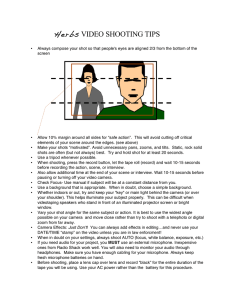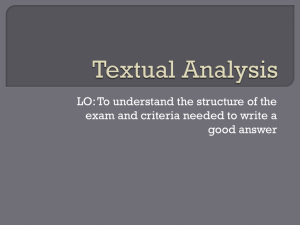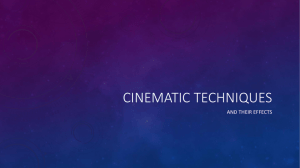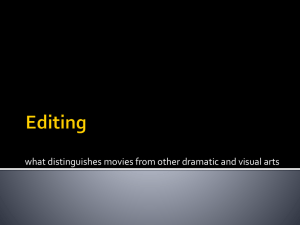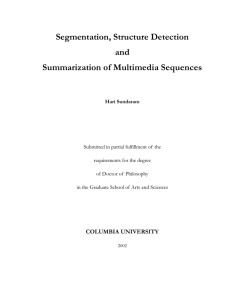NarrativeCameraReview
advertisement
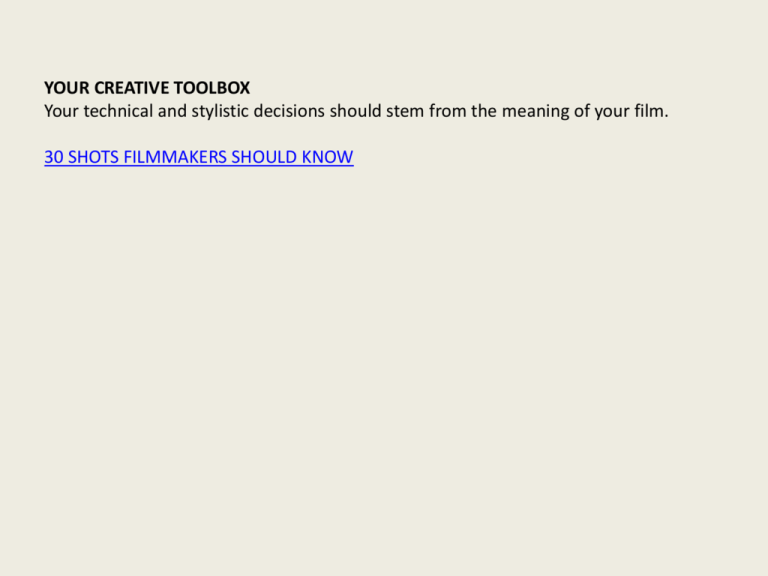
YOUR CREATIVE TOOLBOX Your technical and stylistic decisions should stem from the meaning of your film. 30 SHOTS FILMMAKERS SHOULD KNOW DEEP FOCUS (Great Depth of Field) The whole frame is in focus, the meaning of the scene thus develops in the deep space of the frame. Camera movement, subject movement, dialogue, lighting, costumes, all contribute to the forward movement of the film. LONG TAKE Shot for a long duration, allow the action to unfold in real space and underlines the fact that the shots meaning comes from filming, not from editing. mise en scène – The setting or surrounding of an event, the stage, the integrity of the photographed space or constructed image. The long take has the ability to convince the viewer that what is seen on the screen actually occurred. Long take: LAWRENCE OF ARABIA, Steady cam long takes: RUSSIAN ARK, Aleksandr Sokurov TRUE DETECTIVE , CLASSIC editing/shooting style MASTER SHOT + CLOSEUPS A relatively wide angle, continuous take, to ensure that the audience was oriented and comfortable in the setting before cutting in. Then as actors speak and respond, there are close ups showing facial expressions, etc. CABINET OF DR. CALIGARI, Robert Vina MASTER SHOT One approach to capturing a scene, shoot the entire action in a single, continuous master shot, may be little or no camera movement. Can help emphasize performances and writing, and may de-emphasize the filmic aspects of the scene. ANNIE HALL, Woody Allen TRADITIONAL editing/shooting style – 180 degree Rule TWO PERSON SCENE (using 4 camera angles) 1. Master Shot 2. Two-Shot 3. Close-Up of one character 4. Reverse Close-Up of the other MONTAGE The meaning and forward movement are conveyed through editing, juxtaposing various shots. When the action of a scene is captured in many shorter shots, the filmmaker can control pacing and direct the audience’s attention in ways that may not be possible with a long take. Can also open possibilities for entirely new meanings, deliver enormous emotional impact or bring out otherwise buried meaning. Audiences will suspend belief and enter into the world of the movie. Staging and Editing are not opposites, but 2 stylistic tools at the filmmakers’ disposal. REALISM Merges documentary and narrative sensibilities, shoot dramas with hand held camera. Asking subjects to improvise, elaborate on script. final scene, NASHVILLE by ROBERT ALTMAN Martin Scorsese on CASSAVETES STORYTELLING TIPS - A balance of moments that are described in detail (those that are truly important for interest, meaning, emotional effect) with moments where the action is condensed or can be discarded all together (move through story points that may be necessary but are not themselves worthy of screen time) - The script should be written with attention to which scenes, dialogue and details are truly important and which can be condensed or discarded. - Compressing time can be done with dialog, voice over or jump cuts. - Extending time can be done with blocking the scene (shoot from many angles) and adding more screen time, or adjusting the speed of the clip. - When planning Coverage, director should decide which scenes should be covered in detail. Shots may end up dull and discarded in the editing. - Reveal action, rather than explain it. Don’t use script to describe important elements, use the camera to let the viewer experience them. Use mystery and discovery to your advantage. POINT OF VIEW POINT OF VIEW From what perspective is your story or scene going to be told? Film has the ability to influence our thoughts and emotions and allow us to see the world through the eyes of real or fictional characters. What audiences know about the characters, which ones they identify with, depends on how scenes are constructed and the story unfolds. Can be very subjective, meant to reveal what the audience would see if they were inside the character’s head. Or can place viewer within the scene. CITIZEN KANE, by Orson Wells NARRATIVE SHORT Group Project, 3-4 minutes in length Create a sound design, you may use Garageband and mix recorded audio. Absolutely No Pre-Recorded Music is allowed! (i.e. your favorite songs, etc.) Keep the dialog MINIMAL. This exercise is about building a moment, you don't want too much time on people talking. You want to use the tools of film making to bring us an experience. Consider setting, available lighting, point of view, blocking (angle of camera), coverage (shoot the full scene using an establishing wide shot, then medium and close-up shots), audio and video continuity and decide which scenes should be expanded or condensed in time to best impact your story. Choose A or B: A: Shoot and edit together a meeting between two people. B: Shoot and edit together two parallel events, eventually tying them together in some way
